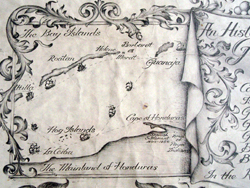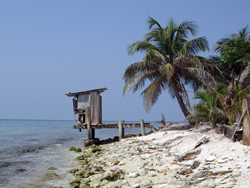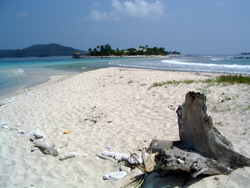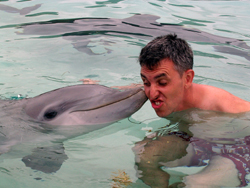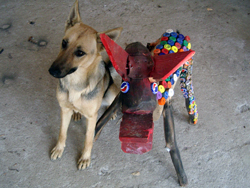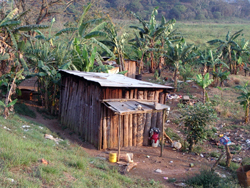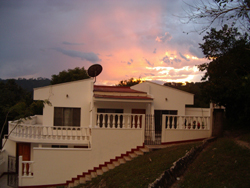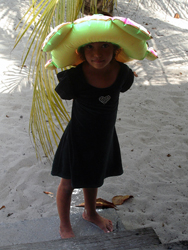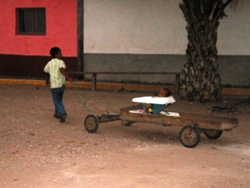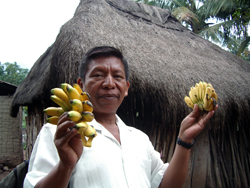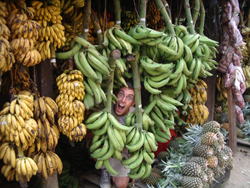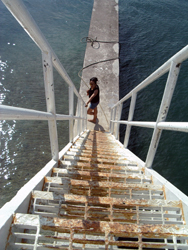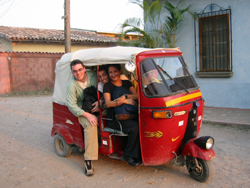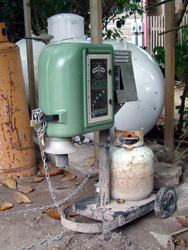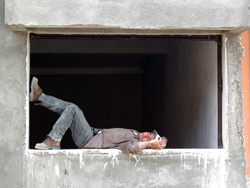Coconuts, Coca-Cola & Cayos Cochinos
Dispatch from the Bay Islands, Honduras - March 2005
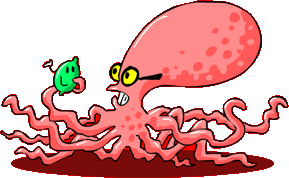
| Cockeyed on the Cayos The
Hog Islands (called the Masaqueras by the early colonists) are now called
the Cayos Cochinos. One assumes the poor pigs have long since been hunted
to extinction because there didn’t seem to be any. Although the
islands are now under Honduran rule the occupants are foreigners, mostly
it seems European being served and waited upon by the local Garífuna
families. There are two main islands and thirteen smaller “cays”
or “cayos” or even “keys” surrounded by a pristine
reef. Only one island (Chachuate) remains “public” and is
home to a vibrant traditional fishing community who survive by (surprise)
fishing and selling a potent alcoholic brew called “yibidee”
to people like me who’s curiosity is greater than the warning
signs thrown up when presented with a plastic cup of liquor that smells
like a combination of cough medicine and gasoline. |
|
|
|
According to the guide book, the Cayos are “possibly the most spectacular and pristine islands in the Caribbean”. It would be hard to disagree with that statement. The Cayos were declared a biological marine reserve in 1994, and were formerly managed by the Smithsonian Tropical Research Institute who for an unknown and mysterious reason abandoned their post a year ago. It is illegal to anchor on the reef or do commercial fishing. One of the islands has a point called “Bonker’s Nose” although no one I asked seemed to know why. |
| We
stayed on Cayo Culebra (snake Island) hopefully named for the shape
rather than the local fauna. There are pink boas in these parts. We
were joined by our dear chum Tim, and several our wonderful new friends.
The island belongs to a 76-year old Italian Supermarket magnate why
uses it but twice a year. In the meantime the entrepreneurial and underpaid
staff exact their revenge on the miserly millionaire by renting it out
illicitly to small groups of delighted tourists who are boated in from
the mainland to pretend to be millionaires for a few days. |
|
|
There
was a
large wooden house—far from rustic—on a perfect Caribbean
Island surrounded by impossibly clear blue water. It took about eight
minutes to walk barefoot around the entire island which had the ubiquitous
desk calendar white beaches, coconut palms and almond trees. There were
expensive Italian hygiene products in the bathrooms and an impressive
collection of fine bound books and maps. There were also three dogs
(Peligro, Muñeca and Violeta) all of whom were adorable by day
and hounds of hatred come nightfall where they would attack anytime
a boat approached or anyone dared step off the deck. |
|
Only 35 minutes by boat rom the contaminated shores on the mainland, the water was a veritable tropical fish tank. According to the weighty tome on Caribbean fish identification, we saw snooty truckfish, stoplight parrotfish, yellowtail damselfish, rays, octopi and my personal favorite, the adorably comical redlip blenny (Ophioblennius Atlanticus) which looks like a mudskipper wearing lipstick and provided me with hours of unexplainable underwater pleasure. |
|
|
Sadly, even this remote paradise was afflicted with the sad vestiges of global capitalism and consumption. I began a cleanup campaign to rid the island of plastic drink bottles which appeared to comprise 95% of the flotsam and jetsam washed ashore by the daily tides. After eight sacks I had cleaned only a tiny fraction of the island. There must have been over 2000 bottles in total, tossed from the bows of cruise ships, abandoned by drunks to the tides, blown from the mainland trash heaps by storms and deliberately discarded by the evil “literati” of the world. A pox on all of them. And may the acrid black smoke from the burn pile end up depleting their own personal ozone layer. |
Plodding Onwards Twenty months into our service and things happen now which may have raised an eyebrow before but now pass us by registering barely a blip on the culture shock radar…. our neighbor got carjacked… we watched a large dog being run over and killed by a truck… we were on a bus that ran over a different dog… busses are regularly stopped and all males aged 18-30 are asked to get of the bus and have their bodies examined for gang tattoos… huge piles of spilled bananas lay on the freeway next to an overturned semi… body parts are laid out at the side of the road next to a car accident. Just another day in Honduras. |
|
|
Lately we received the rather shocking report that they'd been a double murder in our community of barely 1000 people. Two brothers who were driving a gasoline truck had been hog-tied, robbed and executed gangland-style before having their bodies dumped in our local quarry. When we informed [name of international volunteer organization removed by request] they said we needn’t worry because the murder(s) took place “outside” of our immediate vicinity and the bodies were then dumped close by. We slept much better knowing that information. |
I came to the end of a long exhausting semester where I had been teaching a class of teachers how to teach computer teaching classes. One of the final projects I set was for everyone to create a PowerPoint presentation on a famous person using information they could find on the internet. Among the famous people chosen were Che Guevara, Celia Cruz and Enrique Iglesias. Shortly after I finished the class the Cultural Center fired my counterpart and administrator and left me pretty much in charge of everything until I pointed out that this was not sustainable development. If truth be told, working in a computer center was beginning to resemble my previous life a little too much so maybe it will do me good to branch out into other projects. |
|
|
|
The
Guardian Weekly is still happy to publish my travel tales [here]
and Honduras This Week, the weekly English language newspaper in Honduras
is equally happy to pillage cartoons from my website without permission.
Seeds I planted many moons ago are suddenly bearing fruit. My AMUPROLAGO
website finally
made it to the Internet and the first of my Eco-Tourism maps went into
distribution to much applause (although peppered with religious quotations
and my name spelled “Lemmon”). I was one of the last people
to see the final map. The vice-mayor of our town was given some maps
for me but ended up selling them elsewhere and keeping the money. Ahh,
that famous Honduran “corruption”. Better still my arugula
proved hearty enough to sprout and thus, probably for the first time
ever in this corner of Honduras, gourmet salad was served. |
Good deeds Closer
to home we are building a school in a tiny subsistent community called
El Zapotal. It’s so remote that even Coca-Cola and Pepsi have
not managed to penetrate this territory, partly because to reach it
you have to walk two hours along a river (there are no roads) sometimes
hopping from stone to stone or wading knee deep. The community grows
miniature bananas and makes hats out of “junco” a kind of
dried reed. These cowboy hats take three days to make and are then sold
to a “coyote” for 10 Lempiras (about 45 cents). Thanks to
the wonders of modern capitalism the coyote then sells them in town
for ten times the price. The community has a “school” that
is made of sticks and mud and is falling down and that is hardly conducive
to studying. |
|
|
|
Wasp Club Nature
is fascinating. There exists in Honduras a large wasp called a "Tarantula
Wasp" (Hemipepsis spp. ) whose sting can immobilize but not kill
a tarantula. This the female does when pregnant, then, after dragging
the paralyzed tarantula (several times her own weight) to its lair,
she lays her on egg on the fur of the still writhing arachnid and buries
it alive up to 24" deep before plugging up the entrance. The young
wasp lava hatches and feeds on the still fresh meat, eating the tasty
spider alive from inside to out. A gruesome way to go but the sight
of a 2” blue wasp with luminous orange wings dragging a 6”
tarantula along a river bed is a true inspiration to any champion of
the underdog such as me. |
What’s Knitting Kittens? Strange sightings on the seafront at Tela. We thought we saw a man walking a cat on a string but it was actually a Kinkajou (Potos flavus) known in these parts as a "Martilla" or Mico de Noche (which translates more or less to "evil monkey of darkness"). The owner said he had “found it” and he was looking for a sanctuary for it. Apparently the name is an indigenous word for “honey bear” although according to Merriam-Webster's Collegiate Dictionary it says the name is thought to be a French alteration of the Algonquian word for wolverine, “quincajou”. Believe who you like. Personally I prefer the Honey Bear. If you are not familiar with the kinkajou I can attest they are probably the most adorable animals ever invented. They are the disposition and size of a small monkey with bush baby eyes, cotton-soft fur and the enviable prehensile tail. |
|
|
|
All in the Family My
awesome brother came to visit. He was taking a break from his life as
a high flying banker and father of three children. Thus we were unable
to resist the urge to take him to Roatan—the “tourist”
island off the north coast of Honduras—to pretend we weren’t
in Honduras anymore doing non-Honduran type activities and paying non-Honduran
prices, although to be fair it is stunningly beautiful and worth every
penny. We got to witness the disgraceful contents of a Spring Break
cruise ship which spilled onto the beaches during the daylight hours.
The west end of the island (known helpfully as “West End”)
was littered with inebriated, retching, raucous, vociferous, obnoxious
North American teens, giddy on liberal drinking laws and cheep beer.
Many didn’t even know what country they were in. |
Favorite
item on Roatán was a three-person submarine that goes down 2000
feet. The cheerful poster showed a delighted dog in the cabin, no doubt
craving a passing catfish. For $250 a person (more than a month’s
income for us) we were not sadly able to afford a ride. US prices however
mean you can get arugula salad with gorgonzola cheese and walnuts (hold
he bacon sprinkles). I went snorkeling and got stung by a bee (above
the water and not by an underwater bee with a miniature oxygen tank
and fins). Finally we were all lovingly molested by a dolphin called
Bill in a special eco-dolphin sanctuary resort. The most curious thing
we saw on Roatán was a large device called a mosquito magnet.
The machine wasn’t turned on when we were there but neither were
there any mosquitoes. |
|
|
Stop Making Cents Living
on $240 a month can be challenging. This is as much as we get each as
our “living allowance” from which $85 goes towards rent.
However compared to the average Honduran we live on an income equal
to that of corrupt politicians. An outstanding cup of fresh gourmet
coffee is a mere five cents a cup (six if you want powdered milk). You
can get your hair buzzed for a buck. An apple would set you back forty
cents (somewhat pricey). These are all luxuries for the humble Honduran
“campesino”, some of whom have no income and survive by
subsistent farming on small patches of semi-fertile land. Others will
try to sell illegally chopped firewood in the nearby town or city in
the hope of raising ten cents a day if lucky. |
The Circus Comes To Town Not once but twice! A Mexican circus proudly proclaiming itself “King Black’s Circo de Fieras” (Circus of Savage Beasts) rolled into Santa Cruz de Yojoa. The beasts in question--three sad looking lions—are the highlight of a show which included myriad clowns, a strongman act involving a rather disturbing pendulum mechanism, a Guatemalan contortionist and a Honduran trampoline bouncer. The best moment was when a monkey who had been riding in circles on a horse managed to elude his handler and escape. He ran several times around the seats before its trailing leash proved his downfall and he was “captured” once again. A few weeks later a different and much more modest circus (also from Guatemala) rolled into Zacapa. After boasting my performance art credentials, the delightful proprietors (Juan and Julia) told me I was welcome to do a spot as a juggling clown. I have to say I was tempted. There can’t be many people who can say they ran away from international volunteer work to join the circus. Until
next time. |
|
|
The Ink that Thinks Q. What happens when you put Lemon in charge of a publication funded by US taxpayer money? A.
You get Che Guevara on the cover! |

Previous dispatch | Next dispatch
©
J. Lemon / Lemonworld 2005. All rights reserved. This
web site is not an official publication of the Peace Corps or the U.S.
Government. The contents of this Web site reflect the personal opinions
and observations of the individual(s) contributor(s) and do not reflect
any position of the U.S. Government or the Peace Corps. |
